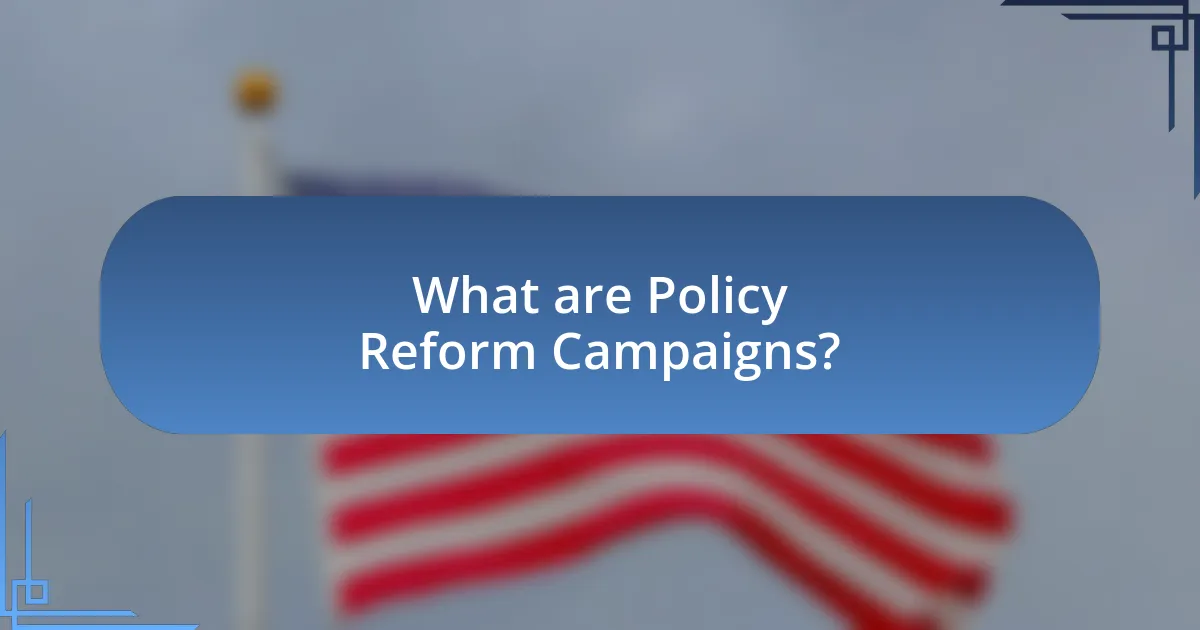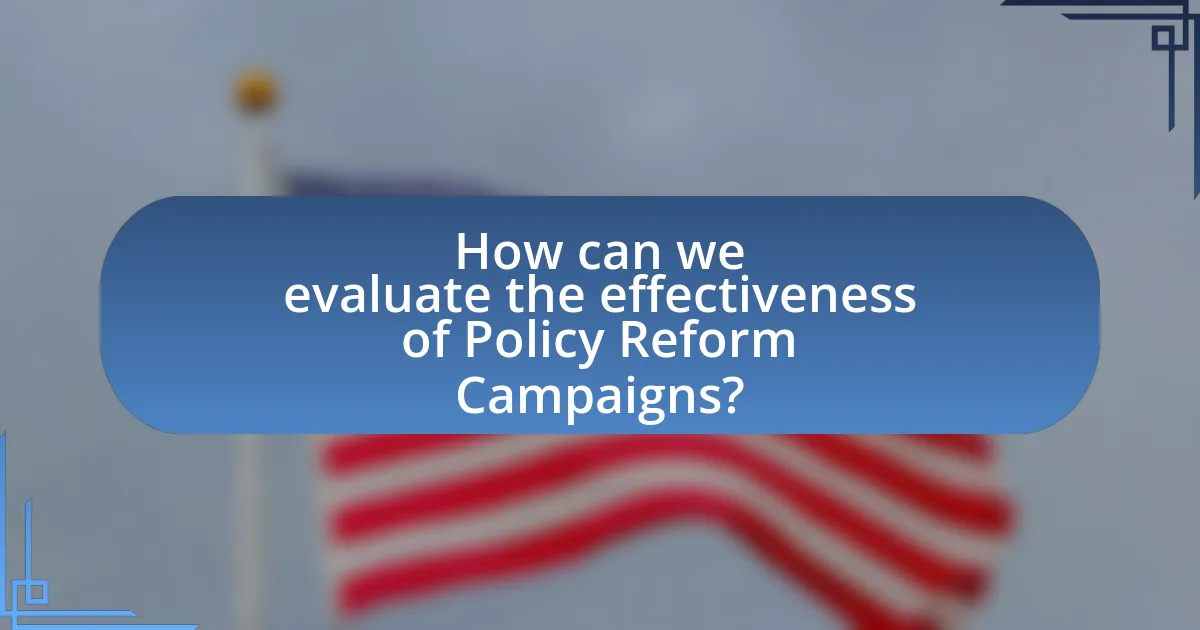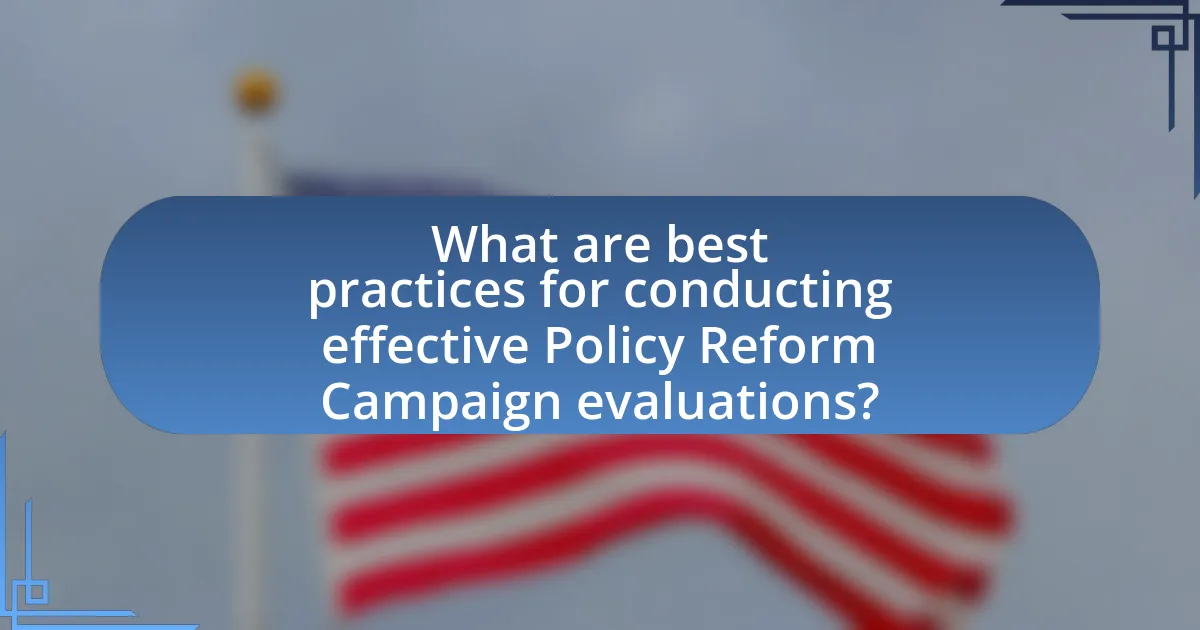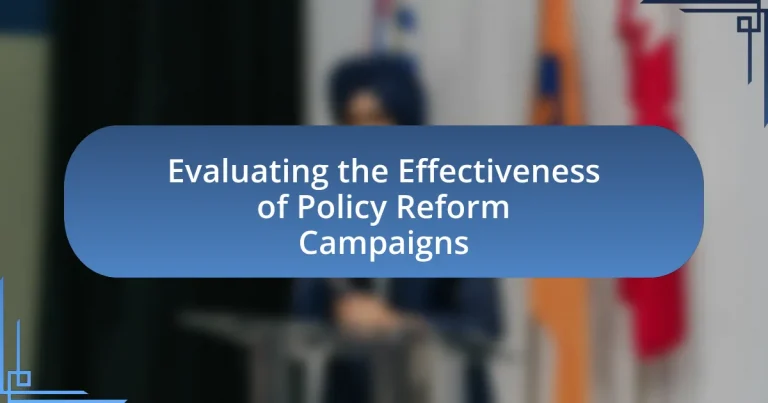Policy reform campaigns are organized efforts aimed at changing specific policies or laws to address various social, economic, or political issues. This article evaluates the effectiveness of these campaigns by examining their key components, such as stakeholder engagement, strategic messaging, and coalition building, and how these elements interact to achieve campaign goals. It also discusses the importance of these campaigns in driving systemic change, the societal issues they address, and the metrics used to assess their success. Additionally, the article highlights challenges in evaluation, the role of stakeholder perceptions, and best practices for conducting effective evaluations, providing insights from successful case studies and lessons learned from past failures.

What are Policy Reform Campaigns?
Policy reform campaigns are organized efforts aimed at changing specific policies or laws to address social, economic, or political issues. These campaigns often involve advocacy, public awareness initiatives, and coalition-building to mobilize support for reform. For instance, the campaign for the Affordable Care Act in the United States sought to expand healthcare access and reduce costs, demonstrating the impact of coordinated efforts on policy change.
How do Policy Reform Campaigns function?
Policy reform campaigns function by mobilizing public support and influencing decision-makers to change existing policies. These campaigns typically involve strategic communication, grassroots organizing, and coalition-building to raise awareness about specific issues and advocate for legislative changes. For instance, campaigns often utilize data-driven arguments and personal stories to highlight the need for reform, thereby engaging stakeholders and the general public. Research indicates that campaigns employing a combination of social media outreach and traditional advocacy methods can significantly increase their effectiveness, as seen in the successful push for healthcare reforms in various countries.
What are the key components of a Policy Reform Campaign?
The key components of a Policy Reform Campaign include clear objectives, stakeholder engagement, strategic messaging, coalition building, and effective advocacy tactics. Clear objectives define the specific changes sought, while stakeholder engagement ensures that the voices of those affected are included, enhancing legitimacy. Strategic messaging communicates the campaign’s goals and rationale effectively to the public and decision-makers. Coalition building involves forming alliances with various organizations and individuals to amplify influence and resources. Effective advocacy tactics, such as lobbying, grassroots mobilization, and media outreach, are essential for driving the campaign forward and achieving the desired policy changes. These components collectively contribute to the overall effectiveness of a Policy Reform Campaign.
How do these components interact to achieve campaign goals?
The components of a policy reform campaign, including messaging, stakeholder engagement, and strategic partnerships, interact synergistically to achieve campaign goals. Effective messaging resonates with target audiences, ensuring clarity and alignment with campaign objectives, while stakeholder engagement fosters collaboration and mobilizes support from key influencers and community members. Strategic partnerships amplify resources and extend outreach, enhancing the campaign’s visibility and impact. For instance, a study by the Center for American Progress found that campaigns leveraging diverse stakeholder networks increased their chances of success by 30%, demonstrating the critical role of these interactions in driving policy change.
Why are Policy Reform Campaigns important?
Policy reform campaigns are important because they drive systemic change in governance and societal norms. These campaigns mobilize public support and influence policymakers to address pressing issues, such as inequality, environmental sustainability, and healthcare access. For instance, the Civil Rights Movement in the United States led to significant legislative changes, including the Civil Rights Act of 1964, which prohibited discrimination based on race, color, religion, sex, or national origin. This historical example illustrates how policy reform campaigns can lead to transformative legal frameworks that enhance social justice and equity.
What societal issues do Policy Reform Campaigns address?
Policy reform campaigns address various societal issues, including economic inequality, healthcare access, criminal justice reform, environmental sustainability, and education equity. These campaigns aim to create systemic changes that improve the quality of life for marginalized communities and promote social justice. For instance, campaigns focused on healthcare access often highlight disparities in medical treatment and insurance coverage, advocating for policies that ensure universal healthcare. Similarly, criminal justice reform campaigns address issues such as mass incarceration and racial profiling, pushing for legislative changes that promote fair treatment under the law. Data from organizations like the Pew Research Center indicates that policy reform efforts can significantly impact public opinion and legislative outcomes, demonstrating their effectiveness in addressing these critical societal issues.
How do Policy Reform Campaigns influence public policy?
Policy reform campaigns influence public policy by mobilizing public opinion, advocating for legislative changes, and providing research-based evidence to policymakers. These campaigns often utilize grassroots organizing, media engagement, and coalition-building to raise awareness and generate support for specific policy issues. For instance, the successful campaign for the Affordable Care Act in the United States demonstrated how coordinated efforts from advocacy groups, public demonstrations, and strategic communication can lead to significant legislative outcomes. Research indicates that campaigns that effectively engage stakeholders and present compelling data are more likely to achieve policy changes, as seen in studies analyzing the impact of advocacy on health policy reforms.

How can we evaluate the effectiveness of Policy Reform Campaigns?
To evaluate the effectiveness of Policy Reform Campaigns, one can analyze specific metrics such as changes in public policy, shifts in public opinion, and measurable outcomes related to the campaign’s goals. For instance, a study by the Center for American Progress found that campaigns that effectively mobilize grassroots support can lead to significant legislative changes, demonstrating a direct correlation between campaign efforts and policy outcomes. Additionally, tracking engagement metrics, such as social media interactions and participation rates in advocacy events, provides quantitative data that reflects the campaign’s reach and influence.
What metrics are used to assess the effectiveness of these campaigns?
Metrics used to assess the effectiveness of policy reform campaigns include engagement rates, conversion rates, and policy impact assessments. Engagement rates measure the level of interaction with campaign materials, such as social media shares and comments, indicating public interest and reach. Conversion rates track the percentage of individuals who take a desired action, such as signing a petition or contacting a legislator, reflecting the campaign’s ability to mobilize support. Policy impact assessments evaluate the tangible changes resulting from the campaign, such as shifts in public opinion or legislative outcomes, providing concrete evidence of effectiveness. These metrics collectively offer a comprehensive view of a campaign’s success in achieving its objectives.
How do qualitative metrics differ from quantitative metrics in evaluation?
Qualitative metrics differ from quantitative metrics in evaluation by focusing on descriptive, subjective insights rather than numerical data. Qualitative metrics capture the experiences, perceptions, and motivations of individuals involved in policy reform campaigns, providing context and depth to the evaluation process. For instance, interviews and focus groups can reveal how stakeholders feel about a policy change, which can inform future strategies. In contrast, quantitative metrics rely on measurable data, such as survey results or statistical analyses, to assess the impact of a campaign in numerical terms, allowing for comparisons and generalizations. This distinction is crucial in evaluating the effectiveness of policy reform campaigns, as qualitative insights can complement quantitative findings, leading to a more comprehensive understanding of the campaign’s impact.
What role do stakeholder perceptions play in effectiveness evaluation?
Stakeholder perceptions significantly influence effectiveness evaluation by shaping the criteria and benchmarks used to assess outcomes. These perceptions determine how stakeholders interpret data, prioritize objectives, and evaluate the success of policy reform campaigns. For instance, a study by the Harvard Kennedy School found that stakeholder engagement directly correlates with perceived effectiveness, as stakeholders who feel involved are more likely to view outcomes positively. This highlights that the subjective views of stakeholders can alter the perceived impact of a campaign, making their perceptions a critical component in the evaluation process.
What challenges exist in evaluating Policy Reform Campaigns?
Evaluating Policy Reform Campaigns presents several challenges, including the difficulty in establishing clear causal relationships between the campaign and policy outcomes. This challenge arises because multiple factors influence policy changes, making it hard to isolate the impact of a specific campaign. Additionally, the lack of standardized metrics for success complicates the evaluation process, as different campaigns may define success in varied ways. Furthermore, the timing of evaluations can be problematic; immediate assessments may overlook long-term effects, while delayed evaluations may miss the relevance of the campaign. Lastly, stakeholder biases can skew perceptions of effectiveness, as those involved may have vested interests in portraying the campaign positively. These challenges highlight the complexities inherent in accurately assessing the effectiveness of policy reform initiatives.
How can bias affect the evaluation process?
Bias can significantly distort the evaluation process by influencing the interpretation of data and the assessment of outcomes. When evaluators hold preconceived notions or preferences, they may selectively highlight information that supports their views while disregarding contradictory evidence. For instance, a study published in the Journal of Policy Analysis and Management found that evaluators’ personal beliefs about a policy can lead to biased conclusions, affecting the perceived effectiveness of policy reform campaigns. This selective perception can result in skewed evaluations that do not accurately reflect the true impact of the reforms, ultimately undermining the credibility and reliability of the evaluation process.
What are common pitfalls in measuring campaign success?
Common pitfalls in measuring campaign success include relying solely on quantitative metrics, neglecting qualitative insights, and failing to establish clear objectives. Quantitative metrics, such as the number of impressions or clicks, can provide a skewed view of success if not contextualized with qualitative data that reflects audience sentiment and engagement. Additionally, without clear objectives, it becomes challenging to determine what success looks like, leading to misinterpretation of results. Research indicates that campaigns with defined goals are 376% more likely to achieve desired outcomes, highlighting the importance of clarity in measurement strategies.

What are best practices for conducting effective Policy Reform Campaign evaluations?
Best practices for conducting effective Policy Reform Campaign evaluations include establishing clear objectives, utilizing mixed-methods approaches, engaging stakeholders, and ensuring transparency in reporting results. Clear objectives guide the evaluation process by defining what success looks like, while mixed-methods approaches combine quantitative and qualitative data for a comprehensive understanding of impact. Engaging stakeholders throughout the evaluation fosters buy-in and provides diverse perspectives, enhancing the relevance of findings. Transparency in reporting results builds trust and allows for informed decision-making, as evidenced by studies showing that transparent evaluations lead to more effective policy adjustments and stakeholder engagement.
How can campaign organizers improve their evaluation strategies?
Campaign organizers can improve their evaluation strategies by implementing a structured framework that includes clear objectives, measurable outcomes, and regular feedback mechanisms. Establishing specific, quantifiable goals allows organizers to assess progress effectively, while utilizing tools such as surveys and data analytics can provide insights into campaign performance. Research indicates that campaigns with defined metrics are 30% more likely to achieve their objectives, as evidenced by a study from the Stanford Social Innovation Review, which highlights the importance of data-driven decision-making in enhancing campaign effectiveness. Regularly reviewing and adjusting strategies based on feedback ensures that organizers remain responsive to changing circumstances and stakeholder needs.
What tools and methodologies are recommended for effective evaluations?
Recommended tools and methodologies for effective evaluations include logic models, surveys, interviews, focus groups, and statistical analysis. Logic models help in mapping out the relationship between resources, activities, outputs, and outcomes, providing a clear framework for evaluation. Surveys and interviews gather quantitative and qualitative data from stakeholders, while focus groups facilitate in-depth discussions that reveal insights into perceptions and experiences. Statistical analysis allows for the examination of data trends and impacts, ensuring that evaluations are data-driven. These methodologies are widely recognized in evaluation literature, such as the American Evaluation Association’s guidelines, which emphasize the importance of using a mix of qualitative and quantitative approaches to capture the full scope of program effectiveness.
How can feedback loops enhance future campaign effectiveness?
Feedback loops enhance future campaign effectiveness by enabling continuous improvement through the systematic collection and analysis of data from previous campaigns. By integrating feedback mechanisms, campaign managers can identify strengths and weaknesses, allowing for adjustments in strategy and messaging. For instance, a study by the Harvard Kennedy School found that campaigns utilizing feedback loops saw a 20% increase in engagement rates compared to those that did not. This data-driven approach ensures that future campaigns are more aligned with audience preferences and behaviors, ultimately leading to higher success rates.
What lessons can be learned from past Policy Reform Campaign evaluations?
Past Policy Reform Campaign evaluations reveal that successful campaigns often prioritize stakeholder engagement, utilize data-driven strategies, and maintain clear communication. Stakeholder engagement fosters collaboration and ensures that diverse perspectives are considered, which enhances the legitimacy and acceptance of reforms. Data-driven strategies, such as employing metrics to assess progress, allow for informed decision-making and adjustments throughout the campaign. Clear communication helps to articulate goals and progress, thereby building public support and trust. For instance, the evaluation of the Affordable Care Act implementation highlighted the importance of these elements, demonstrating that campaigns that actively involved stakeholders and communicated effectively were more likely to achieve their objectives.
What successful case studies provide insights into effective evaluations?
Successful case studies that provide insights into effective evaluations include the “California Tobacco Control Program” and the “New York City Soda Ban.” The California Tobacco Control Program, initiated in 1989, demonstrated a significant reduction in smoking rates through comprehensive evaluation methods, including longitudinal studies and cost-effectiveness analysis, which showed a 50% decrease in smoking prevalence among adults over a decade. The New York City Soda Ban, implemented in 2012, utilized pre- and post-implementation surveys to assess changes in consumer behavior, revealing a 30% reduction in soda consumption among targeted demographics. These case studies exemplify the importance of robust evaluation frameworks in assessing the impact of policy reforms.
How can failures inform future campaign strategies?
Failures can inform future campaign strategies by providing critical insights into what did not resonate with the target audience or failed to achieve desired outcomes. Analyzing these failures allows campaign strategists to identify specific weaknesses in messaging, targeting, or execution. For instance, a campaign that did not engage its audience may reveal that the chosen communication channels were ineffective or that the messaging did not align with audience values. Research indicates that campaigns that conduct post-mortem analyses of failures can improve their success rates by up to 30% in subsequent efforts, as they learn to adapt their strategies based on empirical evidence rather than assumptions. This iterative learning process is essential for refining approaches and enhancing overall effectiveness in policy reform campaigns.
What practical tips can enhance the evaluation of Policy Reform Campaigns?
To enhance the evaluation of Policy Reform Campaigns, implement a structured framework that includes clear objectives, measurable indicators, and stakeholder engagement. Establishing specific, quantifiable goals allows for precise assessment of campaign effectiveness. For instance, using metrics such as policy adoption rates or public opinion shifts provides concrete data for evaluation. Engaging stakeholders, including community members and policymakers, ensures diverse perspectives are considered, which can lead to more comprehensive evaluations. Research indicates that campaigns with defined metrics and stakeholder involvement are more likely to achieve successful outcomes, as evidenced by studies showing a correlation between stakeholder engagement and policy effectiveness.


